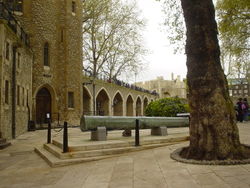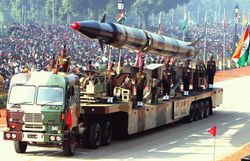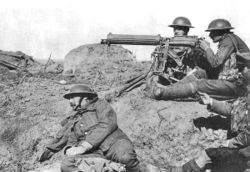Weapon
2008/9 Schools Wikipedia Selection. Related subjects: Engineering; Military History and War
| WarMilitary History |
|---|
|
Eras
Battlespace
Weapons
Organization
Logistics
Lists
War Portal |
A weapon is a tool employed to gain a tactical advantage over an adversary, usually by injury, defeat, or destruction.. There are a huge variety of weapons, which all have different means of coercion. Weapons may be used to attack and defend, and consequently also to threaten or protect. Metaphorically, anything used to damage (even psychologically) can be referred to as a weapon. A weapon can be as simple as a club or as complex as an intercontinental ballistic missile.
History
A weapon is an object that is used to increase the destructive range and/or power of the wielder. Weapons are used in the hunting of animals, as well as in conflicts between humans. From the earliest traces of mankind up to modern civilization, weapons have been a facet of human development. In modern times, weapons development has accelerated along with technological development in general. In ancient times, from the dawn of humanity, through the Classical civilizations of Greece and Rome, and until the widespread introduction of gunpowder weaponry in the Renaissance, weapons were primarily extensions of an individual's strength, essentially making up for the human body's lack of natural weapons such as claws. These weapons allowed the bearer to be substantially more deadly and lethal than a similar human without such a weapon. Although many weapons made in ancient times were steel, wooden ones were also very common.
The earliest weapons used by man for hunting purposes are the Schöninger Speere, eight wooden spears discovered between 1995 and 1998 in a surface mine in Schöningen, Germany. According to various sources, they are about 400,000 years old, making them part of human life in the Lower Paleolithic era.
The Medieval period, including the Western Middle Ages, was characterized by two iconic weapons: knights, heavily-armored horsemen, and castles, fortified dwellings which proliferated throughout Europe and the near est. While knights harked back to earlier historical cavalry such as the Roman and Persian cataphracts, castles triggered quite revolutionary advances, including increasingly sophisticated siegecraft.
The Renaissance marked the beginning of the implementation of combustion powered devices in warfare. The most long-lasting effect of this was the introduction of guns and rockets to the battlefield, which are still at the core of modern weaponry. However, many other machines of war were experimented with.
From the American Revolution through the beginning of the 20th century, human-powered weapons were finally excluded from the battlefield for the most part. Sometimes referred to as the "Age of Rifles", this period was characterized by the development of firearms for infantry and cannons for support, as well as the beginnings of mechanized weapons such as the machine gun.

World War I marked the entry of fully industrialized warfare, and weapons were developed quickly to meet wartime needs. Many new technologies were developed, particularly in the development of military aircraft and vehicles. World War II however, perhaps marked the most frantic period of weapons development in the history of humanity. Massive numbers of new designs and concepts were fielded, and all existing technologies were improved between 1939 and 1945. Ultimately, the most powerful of all invented weapons was the Hydrogen bomb.
After World War II, with the onset of the Cold War, the constant technological development of new weapons was institutionalized, as participants engaged in a constant race to develop weapons and counter-weapons. This constant state of weapons development continues into the modern era, and remains a constant draw on the resources of most nations.
Combustion-powered weapons
Firearms are qualitatively different from earlier weapons because they store energy in a combustible propellant such as gunpowder, rather than in a weight or spring. This energy is released quite rapidly, and can be restored without much effort by the user, so that even early firearms such as the arquebus were much more powerful than human-powered weapons. They became increasingly important and effective during the 16th century to 19th century, with progressive improvements in ignition mechanisms followed by revolutionary changes in ammunition handling and propellant. During the U.S. Civil War various technologies including the machine gun and ironclad warship emerged that would be recognizable and useful military weapons today, particularly in lower-technology conflicts. In the 19th century warship propulsion changed from sail power to fossil fuel-powered steam engines.
The age of edged weapons ended abruptly just before World War I with rifled artillery, such as howitzers which are able to destroy any masonry fortress. This single invention caused a revolution in military affairs and doctrines that continues to this day. See Technology during World War I for a detailed discussion.
An important feature of industrial age warfare was technological escalation - an innovation could, and would, be rapidly matched by copying it, and often with yet another innovation to counter it. The technological escalation during World War I was profound, producing armed aircraft and tanks.
This continued in the period between the end of that war and the next, with continuous improvements of all weapons by all major powers. Many modern military weapons, particularly ground-based ones, are relatively minor improvements on those of World War II. See military technology during World War II for a detailed discussion.

The most notable development in weaponry since World War II has been the combination and further development of two weapons first used in it—nuclear weapons and the ballistic missile, leading to its ultimate configuration: the ICBM. The mutual possession of these by the United States and the Soviet Union ensured that either nation could inflict terrible damage on the other; so terrible, in fact, that neither nation was willing to instigate direct, all-out war with the other (a phenomenon known as Mutually Assured Destruction). The indiscriminate nature of the destruction has made nuclear-tipped missiles essentially useless for the smaller wars fought since. However computer-guided weaponry of all kinds, from precision-guided munitions (or "smart bombs") to computer-aimed tank rounds, has greatly increased weaponry's accuracy.
Information warfare
In modern warfare, since all redoubts are traps, maneuver and coordination of forces are decisive, overshadowing particular weapons. The goal of every modern commander is therefore to "operate within the observation-decision-action cycle of the enemy." In this way, the modern commander can bring overwhelming force to bear on isolated groups of the enemy, and "tactically" overwhelm an enemy.
Traditional military maneuvers tried to achieve this coordination with "fronts" made of lines of military assets. These were formerly the only way to prevent harm to friendly forces. Close-order marching and drill (a traditional military skill) was an early method to get relative superiority of coordination. Derivative methods (such as "leapfrogging units to advance a line") survived into combined arms warfare to coordinate aircraft, artillery, armor and infantry.
Computers are changing this. Attacks are throroughly navigated with great precision.
Thus in modern warfare, satellite navigation systems, digital radios and computers give decisive advantages to ordinary military personnel armed with weapons that are otherwise unremarkable.
Weapon types
There are essentially three facets to classifying weapon types: who uses it, how it works, and what it targets.
Who uses it essentially determines how it can be employed:
- Personal weapons (or Small Arms) are designed to be used by a single person.
- Crew served weapons are larger than personal weapons, requiring more than one crew member to operate correctly.
- Fortification weapons are designed to be mounted in a permanent installation, or used primarily within a fortification.
- Mountain weapons are designed for use by mountain forces or those operating in difficult terrain and harsh climates.
- Vehicle weapons are designed to be mounted on any type of military vehicle.
- Railway weapons are designed to be mounted on railway cars, including armored trains.
- Aircraft weapons are designed to be carried on and used by some type of aircraft, helicopter, or other aerial vehicle.
- Naval weapons are designed to be mounted on ships and submarines.
- Space weapons are designed to be used in or launched from space.
How it works refers to the construction of the weapon and how it operates:
- Antimatter weapons (still theoretical) would combine matter and antimatter to cause a powerful explosion. However, antimatter is still hard to make and harder to store.
- Archery related weapons operate by using a tensioned string to launch a projectile at some target.
- Artillery are large firearms capable of launching heavy projectiles (normally explosive) over long distances.
- Biological weapons spread biological agents, attacking humans (or livestock) by causing disease and infection.
- Chemical weapons spread chemical agents, attacking humans by poisoning and causing reactions.
- Energy weapons rely on concentrating forms of energy to attack, such as lasers, electrical shocks, and thermal or sonic attack.
- Explosive weapons use a physical explosion to create blast concussion or spread shrapnel.
- Firearms use a chemical charge to launch one or more projectiles down a rifled or smoothbore barrel.
- Future weapons make use of futuristic high-tech weapon systems and advanced materials.
- Improvised weapons are common objects that were not designed for combat purposes but are used as such in self defense, guerrilla warfare or a violent crime.
- Incendiary weapons rely on combustible materials and an ignition mechanism to cause damage by fire.
- Non-lethal weapons are used to attack and subdue humans, but are designed to minimize the risk of killing the target.
- Magnetic weapons is one that uses magnetic fields to accelerate and propel projectiles, or to focus charged particle beams.
- Mêlée weapons operate as physical extensions of the user's body and directly impact their target.
- Missiles are rockets which are guided to their target after launch. This is also a general term for projectile weapons.
- Nuclear weapons use radioactive materials to create nuclear fission and/or nuclear fusion detonations above a target ("air-burst") or at ground-level.
- Primitive weapons make little or no use of technological or industrial elements, instead being purely constructed of easily obtainable natural materials.
- Ranged weapons cause a projectile to leave the user and (ideally) strike a target afterwards.
- Rockets use chemical propellant to accelerate a projectile (usually with an explosive warhead) towards a target and are typically unguided once fired.
- Suicide weapons are typically explosive in nature and exploit the willingness of their operator to not survive the attack to reach their target.
What it targets refers to what type of target the weapon is designed to attack:
- Anti-aircraft weapons target enemy aircraft, helicopters, missiles and any other aerial vehicles in flight.
- Anti-fortification weapons are designed to target enemy installations, including bunkers and fortifications. The American bunker buster bomb is designed to travel almost 10 metres underground before detonating, toppling underground installations.
- Anti-personnel weapons are designed to attack people, either individually or in numbers.
- Anti-radiation weapons target enemy sources of electronic radiation, particularly radar emitters.
- Anti-ship weapons target enemy ships and vessels on water.
- Anti-submarine weapons target enemy submarines and other underwater targets.
- Anti-tank weapons are primarily used to defeat armored targets, but may be targeted against other less well armored targets.
- Area denial weapons are designed to target territory, making it unsafe or unsuitable for enemy use or travel.
- Hunting weapons are designed particularly for use against animals for hunting purposes.
- Infantry support weapons are designed to attack various threats to infantry units, supporting the infantry's operations, including heavy machine guns, mortars and pinpoint airstrikes ordered by the infantry, often to strike heavily defended positions, such as enemy camps or extensively powerful machine-gun nests.
Weapons by era
- Ancient
- Medieval
- Technology during World War I
- Military technology during World War II
- Modern weapons
- All eras

